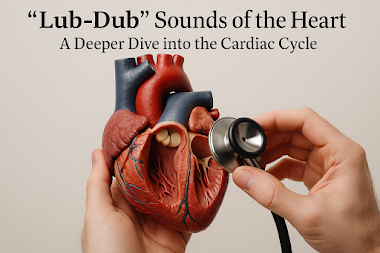The rhythmic "lub-dub" sounds of the heart are among the most familiar and significant physiological cues that indicate the heart is functioning properly. These sounds are not random noises but are caused by the coordinated opening and closing of heart valves during each heartbeat. Each "lub" and "dub" is an acoustic marker of the complex and essential process known as the cardiac cycle.
In this article, we’ll explore what causes these sounds, what they signify, and how they relate to the phases of the cardiac cycle.
What is the Cardiac Cycle?
The cardiac cycle is the sequence of events that occur from the beginning of one heartbeat to the beginning of the next. It consists of systole (contraction) and diastole (relaxation) of both the atria and the ventricles. This cycle ensures that blood flows in a coordinated and unidirectional manner through the heart and to the rest of the body.
The Source of Heart Sounds: Heart Valves
The heart contains four primary valves:
-
Atrioventricular (AV) valves: the mitral (bicuspid) valve on the left side and the tricuspid valve on the right side.
-
Semilunar valves: the aortic valve and the pulmonary valve.
The heart sounds are generated by the closure of these valves during different phases of the cardiac cycle.
The "Lub" Sound (S1)
The first heart sound, commonly described as "lub," is caused by the closure of the atrioventricular (AV) valves—the mitral and tricuspid valves. This event occurs at the beginning of ventricular systole, when the ventricles begin to contract.
As the ventricles contract, pressure within them quickly rises. Once the ventricular pressure exceeds the pressure in the atria, it forces the AV valves to snap shut. This closure prevents the backflow of blood into the atria and creates the distinct "lub" sound that is audible during auscultation with a stethoscope.
The "lub" sound is generally louder and longer than the "dub" and marks the onset of ventricular contraction.
The "Dub" Sound (S2)
The second heart sound, referred to as "dub," is generated by the closure of the semilunar valves—the aortic and pulmonary valves. This sound occurs at the end of ventricular systole, as the ventricles begin to relax.
Once the ventricles eject blood into the aorta and pulmonary artery, the pressure within them drops. When the pressure in the arteries becomes greater than that in the relaxing ventricles, the semilunar valves close to prevent blood from flowing backward into the heart. The closure of these valves produces the "dub" sound.
This sound is typically shorter and sharper than the "lub" and signals the beginning of diastole, or the heart's relaxation phase.
Clinical Importance of Heart Sounds
Listening to heart sounds is a fundamental part of a physical examination. Physicians use a stethoscope to assess the rhythm, strength, and character of the heartbeats. Any abnormalities, such as additional sounds (called murmurs) or changes in the intensity or timing of S1 and S2, can be early indicators of underlying heart conditions such as:
-
Valve stenosis or regurgitation
-
Heart failure
-
Congenital heart defects
Understanding the origin and timing of these sounds is essential for diagnosing and monitoring cardiac health.
Summary
The "lub-dub" sounds of the heart are the result of a beautifully synchronized process that reflects the mechanical efficiency of our cardiovascular system. The "lub" (S1) marks the closure of the mitral and tricuspid valves at the onset of ventricular contraction. The "dub" (S2) indicates the closure of the aortic and pulmonary valves as the ventricles relax.
These two simple yet vital sounds are a testament to the heart's function as a relentless, rhythmic pump, sustaining life with each beat. Recognizing and understanding them not only enhances our appreciation of the human body but also deepens our knowledge of cardiovascular physiology.
For Enquiries: cardiologysupport@


.webp)
.jpeg)

No comments:
Post a Comment